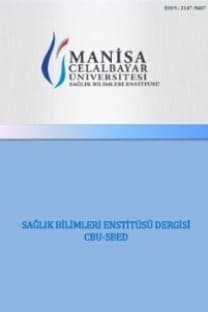Benign Vokal Kord Patolojilerinde Tedavi Etkinliğinin Ses Analizi ile Değerlendirilmesi
Giriş ve Amaç: Benign vokal kord patolojilerinde ses terapisi ve fonocerrahinin etkinliğini belirlemek.Gereç ve Yöntemler: Manisa Celal Bayar Üniversitesi KBB polikliniğine Eylül 2015-Mayıs 2019 tarihleriarasında ses kısıklığı ile başvuran ve akustik ses analizi yapılan 79 (35 K, 44 E) hasta çalışmaya dahil edilmiştir.Ses analizinde hastanın başvuru sırasında ve tedavi sonrası 3. ayda auidio-technica AT2005USB marka mikrofonile alınan kayıtları karşılaştırılmıştır. Akustik analiz çok boyutlu ses analiz programı (Multi-Dimensional VoiceProgram- MDVP) kullanılarak yapılmıştır. F0, vF0, Jitter, Shimmer, APQ, NHR ve VTI parametreleri analizedilmiştir. Ses kayıtları alınmıştır. Ses analizi değerleri gurup bazında tedavi öncesi ve sonrası “eşli örneklem ttesti” kullanılarak karşılaştırılmıştır. Veriler ortalama ± standart sapma (SD) olarak sunulmuştur. Güven aralığı95% ve p
Treatment Effectiveness in Benign Vocal Cord Pathologies Evaluation by Sound Analysis
Objective: To determine the efficacy of voice therapy and phono-surgery in benign vocal cord pathologies. Materials and Methods: 79 (35 K, 44 E) patients who were admitted to the ENT clinic of Manisa Celal Bayar University between September 2015 and May 2019 with hoarseness and who underwent voice analysis were included in the study. Auidio-technica AT2005USB microphone was utilized for comparison of voice at the time of admission and at the 3rd month after treatment. Acoustic analysis was done using a multi-dimensional sound analysis program (MDVP). F0, vF0, Jitter, Shimmer, APQ, NHR and VTI parameters were analyzed. Voice parameters were compared on a group basis before and after treatment by using “paired sample t test”. Data are presented as mean ± standard deviation (SD). The confidence interval was considered statistically significant at 95% and p
___
- 1.Naunheim, MR, Carroll, TL, Benign vocal fold lesions: update on nomenclature, cause, diagnosis, and treatment, Current Opinion Otolaryngology Head Neck Surgery, 2017, 25(6), 453–458.
- 2.Hoffman, HT, Bock, JM, Karnell, LH, Ahlrichs-Hanson, J, Microendoscopy of Reinke's space, Annals of Otology Rhinology Laryngology, 2008, 117(7), 510‐516.
- 3. Malik, P, Yadav, SPS, Sen, R, et al, The Clinicopathological Study of Benign Lesions of Vocal Cords, Indian Journal of Otolaryngology Head Neck Surgery, 2019, 71(Suppl 1), 212‐220.
- 4.White A, Management of benign vocal fold lesions: current perspectives on the role for voice therapy, Current Opinion in Otolaryngology Head Neck Surgery, 2019, 27(3), 185‐190.
- 5.Song, TE, Jiang, N, Transgender Phonosurgery: A Systematic Review and Meta-analysis, Otolaryngology Head Neck Surgery. 2017,156(5),803‐808, doi:10.1177/0194599817697050.
- 6. Ropero Rendón, MDM, Ermakova, T, Freymann, ML, Ruschin, A, Nawka, T, Caffier, PP, Efficacy of Phonosurgery, Logopedic Voice Treatment and Vocal Pedagogy in Common Voice Problems of Singers, Advances Therapy, 2018,35(7),1069‐1086.
- 7. Agarwal, J, Wong, A, Karle, W, Naunheim, M, Mori, M, Courey, M, Comparing short-term outcomes of surgery and voice therapy for patients with vocal fold polyps, Laryngoscope, 2019, 129(5), 1067‐ 1070.
- 8. Cohen, SM, Garrett, CG, Utility of voice therapy in the management of vocal fold polyps and cysts, Otolaryngology Head Neck Surgery, 2007, 136, 742–746.
- 9. Sulica, L, Behrman, A, Management of benign vocal fold lesions: a survey of current opinion and practice, Annals of Otology Rhinology Laryngology, 2003, 112, 827–833.
- 10. Jeong, WJ, Lee, SJ, Lee, WY, Chang, H, Ahn, SH, Conservative management for vocal fold polyps, JAMA Otolaryngology Head Neck Surgery, 2014, 140, 448–452.
- 11. Tang, SS, Thibeault, SL, Timing of voice therapy: a primary investigation of voice outcomes for surgical benign vocal fold lesion patients, Jounal of Voice, 2017, 31,129 e121-129 e127.
- 12. Vashani, K, Murugesh, M, Hattiangadi, G et al, Effectiveness of voice therapy in reflux-related voice disorders, Dis Esophagus, 2010, 23(1), 27‐32.
- 13. Garrett, CG, Francis, DO, Is surgery necessary for all vocal polyps? Laryngoscope, 2014, 124, 363–4.
- 14. Sulica, L, Behrman, A, Management of benign vocal fold lesions: asurvey of current opinion and practice, Annals of Otology Rhinology Laryngology, 2003, 112, 827–33.
- 15. Pedersen, M, McGlashan, J, Surgical versus non-surgical interventions for vocal cord nodules, Cochrane Database Systematic Review, 2001, CD001934.
- 16. Be´quignon, E, Bach, C, Fugain, C, Guillere´, L, Blumen, M, Chabolle, F et al, Long-term results of surgical treatment of vocal fold nodules, Laryngoscope, 2013, 123, 1926–30.
- 17. Wang, CT, Lian, LJ, Lai, MS, Cheng, PW, Comparison of benign lesion regression following vocal fold steroid injection and vocal hygiene education, Laryngoscope, 2014, 124, 510–5.
- 18. Simberg, S, Laine, A, Sala, E, Ro¨nnemaa AM, Prevalence of voice disorders among future teachers, Journal of Voice, 2000, 14, 231–6.
- ISSN: 2147-9607
- Yayın Aralığı: Yılda 4 Sayı
- Başlangıç: 2014
- Yayıncı: Manisa Celal Bayar Üniversitesi Sağlık Bilimleri Enstitüsü
Sayıdaki Diğer Makaleler
Züleyha ERİŞGİN, Şeyma KURT, Yavuz TEKELİOĞLU, Ahmet Uğur AKMAN, Sibel TÜREDİ
İliak Arter ve Alt Ekstremite Periferik Arter Hastalıklarında Endovasküler Tedavi
Süleyman SÜRER, Yüksel BEŞİR, Orhan RODOPLU, Ömer TETİK
Aynur ÇETİNKAYA, Fatma UYAR, Dilek ÖZMEN, DAMLA ŞAHİN, Sinem Sezen KÖKSAL
Boğmaca hastalığına karşı yeni aşı tasarımı ve analizi
Babaların Doğum Eylemine Katılma Konusundaki Görüşleri ve Gereksinimleri
ZEKİYE KARAÇAM, Erdal KARATEPE
Ferhat ÖZYURTLU, Nurullah ÇETİN
Integrative Analysis of SIX1 and Cancer Stem Cell Markers in Hepatocellular Carcinoma
SIX1 ve Kanser Kök Hücre Belirteçlerinin Hepatoselluler Karsinomada Kapsamlı Analizi
